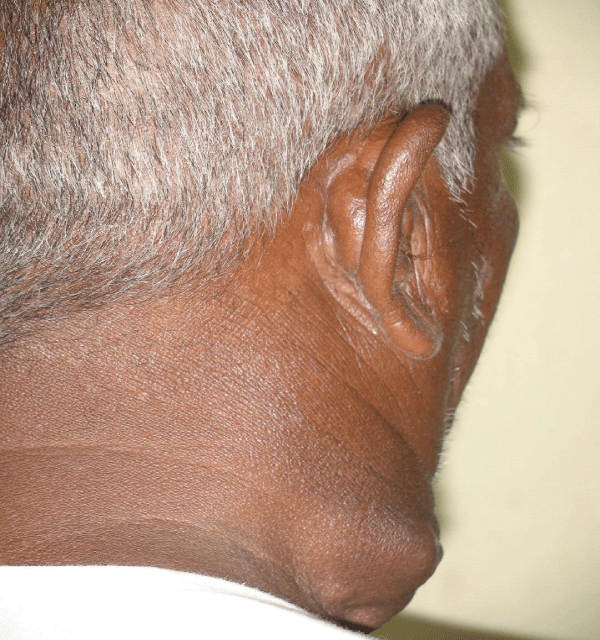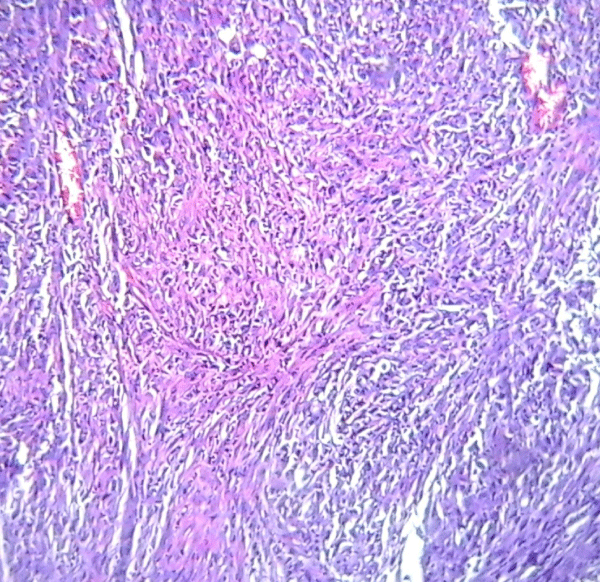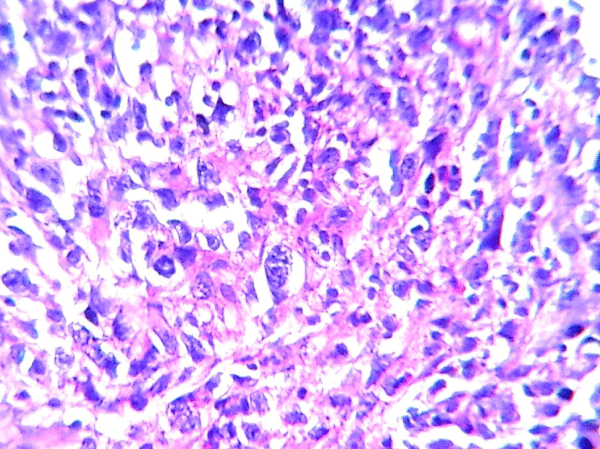A Case of Pulmonary Sarcomatoid Carcinoma with Right Cervical Lymph Node Metastasis?
Premkumar Daivasikamani*
Faculty of Medicine, Asian Institute of Medical Sciences and Technology, Semiling, Kedah, Malaysia
*Address for Correspondence: Premkumar Daivasikamani, Faculty of Medicine, Asian Institute of Medical Sciences and Technology, Semiling, Kedah, Malaysia. Tel: +60-102-690-903; E-mail: [email protected]
Submitted: 21 February 2020; Approved: 05 March 2020; Published: 07 March 2020
Citation this article: Daivasikamani P. A Case of Pulmonary Sarcomatoid Carcinoma with Right Cervical Lymph Node Metastasis. Int J Case Rep Short Rev. 2020;6(3): 007-010.
Copyright: © 2020 Daivasikamani P. This is an open access article distributed under the Creative Commons Attribution License, which permits unrestricted use, distribution, and reproduction in any medium, provided the original work is properly cited
Keywords: Pulmonary sarcomatoid carcinoma; Cervical lymphadenopathy; Pleomorphic carcinoma; Spindle cell carcinoma; Immunocytochemistry; Resection; Chemotherapy; Immunotherapy
Download Fulltext PDF
Pulmonary Sarcomatoid Carcinoma (PSC) is a rare carcinoma occurring in lung. It is difficult to diagnose by clinical methods or by imaging. It can be diagnosed only by histopathology. Though by eosin hematoxylin straining we can diagnose it but most of the time it requires immunocytochemistry testing for epithelial membrane antigen, Carcinoembryonic Antigen (CEA), CD15, and Ber-EP4 or AE1/3, CAM 5.2, CK18, and CK7. Rarely carcinoma of lung produces metastases to cervical lymph nodes. Smoking is a risk factor for Pulmonary Sarcomatoid Carcinoma (PSC). Usual treatment for sarcomatoid carcinoma of lung is same as for other lung carcinoma. It has got bad prognosis compared to other lung carcinoma. We are reporting a case of pulmonary sarcomatoid carcinoma with cervical lymph nodes metastases.
Introduction
Pulmonary sarcomatoid carcinoma is a biphasic tumor characterized by a combination of mesenchymal cells and malignant epithelial cells. Pulmonary sarcomatoid carcinoma is extremely rare carcinoma hence usually presents with advanced local disease and metastasis. A case of pulmonary sarcomatoid carcinoma with cervical lymph nodes metastases is reported here. It is a rare carcinoma of lung. Incidence is more in males than in females. Most of the patients are more than 60 years old. It is common in smokers. It usually spread to mediastinal lymph nodes. Routine staining may not identify the disease but special stains are required to confirm the pulmonary sarcomatoid carcinoma. It is treated by lung resection and if inoperable by radiotherapy or chemotherapy. Prognosis of the tumor is poor. It is difficult to diagnose clinically.
Case History
62 years old man was admitted with history of swelling on the right side of the neck of 4 months duration (Figure 1). He also complained of occasional cough without sputum and hemoptysis. There is loss of weight. He smoked one packet of cigarette for the past 30 years. On examination, right lower deep cervical lymph nodes were palpable of size 4x5 cms. It was hard in consistency and fixed. Respiratory system was clinically normal. X ray chest showed diffuse opacity of size 2 cm in the right lung upper zone. CT scan also showed similar finding with mediastinal lymph nodes enlargement. Cervical lymph node biopsy was done. Histology revealed tumor cells exhibiting sarcoma-like differentiation (spindle cells and giant cell). They were embedded in a myxoid stroma. Spindle cells were arranged in haphazard fascicles and storiform pattern. Few malignant giant cells were dis-cohesive and uninucleate having moderate dense, eosinophilic cytoplasm. Cuboidal cells arranged in glandular pattern suggesting adenoma carcinoma (Figure 2 & Figure 3). Clinical finding suggested metastases in the cervical lymph nodes and X ray chest and CT scan suggested lung carcinoma. Histopathology suggested sarcomatoid carcinoma of lung. Hence clinically, by imaging and histopathology suggested pulmonary sarcomatoid carcinoma with cervical lymph nodes metastases. Though head and neck carcinoma usually produce cervical lymph node metastases in our patient there was no primary in the head and neck and ENT examination was also normal. Histology also did not show squamous cell component. Hence patient was diagnosed as pulmonary sarcomatoid carcinoma with cervical lymph nodes metastases. As it was in advanced stage, the patient was treated with chemotherapy. Patient came for chemotherapy for 6 months then lost in the follow up.
As the intestinal loop was firmly stuck, to avoid forceful manipulation of the loop, a 1 cm cut was performed at the left edge of the hernia orifice to liberate easily the intestine, reducing it back again into the pelvic cavity. No signs of perforation or contamination were found. The hernia was repaired by TAPP approach with polypropylene mesh placement (Figure 3) and the peritoneum was closed with 00 Stratafix® suture.
Discussion
Most of the metastatic cervical lymph nodes arise from primary tumors of the head and neck. Rarely isolated supraclavicular and or lower deep cervical lymphadenopathy should alert the surgeon to consider the possibility of a non-head and neck primary neoplasm. The most common distant primary tumors associated with neck lymph node metastases include cancers of the lungs, breast, kidney and testis. The lymphatic drainage through thoracic duct produces metastases to left-sided supra clavicular or lower deep cervical lymph nodes. The metastases can involve right sided cervical lymph nodes if the primary is in the lung or breast is on the right side. Pulmonary sarcomatoid carcinoma can occur in many sites of the body such as lungs, breast, bladder, colon, uterus, and ovary. Symptoms are like any other lung carcinoma like fever, weight loss, hemoptysis, chest pain, cough, and dyspnea [1]. Pulmonary sarcomatoid carcinoma is common in the male and shows a male-to-female ratio of 7.25:1. It usually present at a mean and median age of 65 years. They most common presentation is solitary masses in the upper lobes and average 7 cm in diameter. 62% of pulmonary sarcomatoid carcinoma is endobronchial or central tumors and 38% are peripheral. The risk of dissemination of small cell carcinoma ranges from 74% to 96%, adenocarcinoma from 50% to 82%, large cell carcinoma from 48% to 86%, and squamous cell carcinoma from 25% to 54% [2]. With the exception of large cell carcinomas and adenocarcinomas, lung cancers rarely metastasize to the neck. When neck metastases occur, the supraclavicular group is most often involved, although involvement of level I and II nodes has also been reported [3]. Metastatic involvement of the supraclavicular lymph nodes by pulmonary malignancies is classified as N3, which is considered to be at least stage IIIB, and involvement of other cervical lymph nodes is classified as M1 (stage IV disease) [4]. Lung carcinoma histologically the most frequent epithelial component is squamous cell carcinoma (46%), adenocarcinoma (31%) and adenosquamous carcinoma (19%), whereas most frequent sarcomatous elements is rhabdomyosarcoma followed by chondrosarcoma, osteosarcoma, or combinations of these elements [5]. The pulmonary sarcomatoid carcinoma is rare and it is a subset of poorly differentiated non–small cell lung cancers. World Health Organization has specified histologic criteria for all the five pulmonary sarcomatoid carcinoma subtypes established by the World Health Organization is straightforward and can readily be applicable to light microscopy [6]. Applying the histologic criteria and appropriate immune histochemical studies and ruling out differential diagnosis will help to diagnose pulmonary sarcomatoid carcinoma. World Health Organization has classified pulmonary sarcomatoid carcinoma into 5 subtypes: pleomorphic carcinoma, spindle cell carcinoma, giant cell carcinoma, carcinosarcoma, and pulmonary blastoma [7]. The CT, MR, and PET scans do not have any specific finding to diagnose pulmonary sarcomatoid carcinoma. By chest imaging we can differentiate between malignant mesothelioma which presents with diffuse pleural involvement and pulmonary sarcomatoid carcinoma forms a solitary parenchymal lung mass. Adequate specimen must be available to diagnosis of pulmonary sarcomatoid carcinoma as small biopsy may be inconclusive. It can be suspected but it is often difficult to confirm unless there is adenocarcinoma, squamous cell carcinoma, or large cell carcinoma, and sarcoma elements. Pulmonary sarcomatoid carcinoma can be diagnosed on the hematoxylin and eosin stained sections. When there is difficulty then Immunocytochemistry seems to be the gold standard for diagnosis of sarcomatoid carcinoma. Carcinoembryonic antigen, EMA, CK, pancreatin, chromogranin A, CD56, and synaptophysin are highly specific markers for the carcinomatous components, while desmin, vimentin, and smooth muscle/sarcomeric actin show an affinity for the sarcomatous elements [1]. Classical presentation of carcinoma and sarcoma components in pulmonary sarcomatoid carcinoma is often inconspicuous; it requires multiple keratin antibodies to be present to demonstrate the epithelial lineage of the spindle and giant cell components of pleomorphic carcinoma. Even if epithelial membrane antigen, Carcinoembryonic Antigen (CEA), CD15, and Ber-EP4 are absent AE1/3, CAM 5.2, CK18, and CK7 are positive. Positive epithelial markers are not required if in the histology the components of adenocarcinoma, squamous cell carcinoma, or large cell carcinoma are present. The presence of TTF-1 denotes the Pulmonary origin of these tumors and it is more sensitive than surfactant protein-A. The most useful immunohistochemical tools for identifying metastatic lung adenocarcinoma are Thyroid Transcription Factor-1 (TTF-1) and Napsin-A [8-10]. The epithelial component of carcinosarcoma will demonstrate the Keratin antibodies and it is diffusely stained by the epithelial component of pulmonary blastoma. Muscle markers and S100 protein will stain the rhabdomyosarcoma and chondrosarcoma, respectively, when present in either carcinosarcoma or pulmonary blastoma. First multi-targeted genetic analysis on a large cohort of pulmonary sarcomatoid carcinoma was done by Fallet and colleagues [11]. Using the Lung Carta Panel on the Sequenom platform mutational assets of 26 oncogenes was demonstrated in 114 surgically resected pulmonary sarcomatoid carcinoma specimens. Mutations in KRAS (34.4%) and TP53 (73.6%) are the most common mutations in PSCs. Less frequent alterations can also be found in NOTCH1, NRAS, and PI3KCA. In 2016, Schrock et al used a deep sequencing approach to map whole-exome mutations in a cohort of 125 PSCs [12]. Immunotherapy by blockade of immune checkpoint pathways like the PD1/PD-L1 signaling has helped to treat many chemo-resistant cancer patients. Immune checkpoints inhibitors use in PSCs relies on two different assumptions. First, immunotherapy has shown promising results in NCSLC by not only improving progression-free but also overall survival with fewer adverse events than standard chemotherapy in a many patients [13]. Second, evidence indicates that the response to immunotherapy is higher in tumors that like PSC and also in general tobacco-associated tumors where there is high degree of genetic damage [14]. Preliminary data are encouraging and seem to corroborate the employment of immune checkpoint blockade as immunotherapy for pulmonary sarcomatoid carcinomas [15]. Activation of MET signaling is frequently associated and functionally supports the Epithelial to Mesenchymal Transition (EMT) which is believed to be a driver mechanism in the progression of pulmonary sarcomatoid carcinoma from well-differentiated lesions [16,17]. The main factors affecting the prognosis is TNM staging. Surgical resection and postoperative adjuvant chemotherapy might result in better prognosis [18]. Statistically, there was no significant prognostic difference between the sarcomatoid carcinoma and non sarcomatoid, non-small cell carcinoma of the lung. Fishback, et al. [19] called pulmonary sarcomatoid carcinoma as pleomorphic (spindle/giant cell) carcinomas of the lung as the same tumors contains both spindle and giant cell components. Prognosis depends on the size and nodal status, if the tumor is larger than 5 cm of if more than one lymph node is present the prognosis is bad. The nodal metastases are the most significant single prognostic factor and the presence of squamous or adenocarcinomatous differentiation did not affect the length of survival. So the assessment of the cervical lymph nodes becomes important to assess the stage of the disease and its prognosis. Prosch, et al. [20] assessed the utility of ultrasound evaluation and ultrasound-guided fine-needle aspiration biopsy for the diagnosis and staging of patients with lung cancer. The enlarged nodes can be missed on CT. In these cases, ultrasound-guided biopsy examination detected malignancy and staged the disease N3 or M1, which avoided or prevented more invasive diagnostic procedures. There is no reported role for neck dissection for cervical metastases from a lung carcinoma. It is important to note that for no adenocarcinomas (ie, squamous or neuroendocrine tumors), the distinction between a lung and head and neck primary cannot be made by histology or immunohistochemistry. This is particularly challenging for management for the approximately 10% of patients with a head and neck squamous cell carcinoma with synchronous presentation of a solitary lung mass. A biopsy of the lung mass confirming a different histology would support 2 separate malignancies, but a squamous histology of both head and neck and lung lesions leave the clinician with the challenge of considering the lung lesion as a metastases or a second primary [21]. However, select patients with isolated supraclavicular lymph node involvement (including those with ipsilateral primary and nodal disease completely included within a radiation portal) can be treated with curative intent with concurrent chemo- radiotherapy. Patients with extensive-stage SCLC have particularly aggressive disease and a median survival on the order of 8 months and 5-year survival ≤ 10%; surgery of metastatic sites is almost never recommended. There is no reported role for neck dissection for cervical metastases from a lung carcinoma. Given that cervical lymph node metastases from remote primary tumors are rare, evidence based recommendations.
- Jia J, Ren J, Gu J, Di L, Song G. Predominant sarcomatoid carcinoma of the lung concurrent with jejunal metastasis and leukocytosis. Rare Tumors. 2010; 2. PubMed: https://www.ncbi.nlm.nih.gov/pubmed/21139960/
- Minna JD, Higgins GA, Glatstein EJ. Cancer of the lung. In: DeVita VT Jr, Lawrence TS, Rosenberg SA, editors. DeVita, Hellman and Rosenberg’s Cancer: Principles & practice of oncology. Philadelphia: Wolters Kluwer Health; 1982. p. 396-474.
- Carlson ER, Reddi SP, Monteleone KL. Metastatic lung cancer of the neck: Report of 2 cases. J Oral Maxillofac Surg. 2002; 60: 1057-1061. PubMed: https://www.ncbi.nlm.nih.gov/pubmed/12215994
- Edge S, Byrd DR, Compton CC, Fritz AG, Greene FL, Trotti A, editors. AJCC cancer staging manual. 7. New York, NY: Springer; 2010. http://bit.ly/3ayGAuW
- Koss MN, Hochholzer L, Frommelt RA. Carcinosarcomas of the lung: A clinicopathologic study of 66 patients z. Am J SurgPathol. 1999; 23: 1514-1526. PubMed: https://www.ncbi.nlm.nih.gov/pubmed/10584705
- Travis WD, Colby TV, Corrin B, Shimosato Y, Brambilla E. Histological typing of lung and pleural tumours. 3rd ed. Berlin, Germany: Springer-Verlag; 1999. Health Organization International Histological Classification of Tumours. http://bit.ly/2VPP64D
- Travis WD, Brambilla E, Muller-Hermelink HK, Harris CC. Pathology and genetics of tumors of the Lung, pleura, thymus and heart. France: IARC Press; 2004. World Health Organization Classification of Tumours. http://bit.ly/2vAYXk6
- Srodon M, Westra WH. Immunohistochemical staining for thyroid transcription factor-1: A helpful aid in discerning primary site of tumor origin in patients with brain metastases. Hum Pathol. 2002; 33: 642-645. PubMed: https://www.ncbi.nlm.nih.gov/pubmed/12152164
- Ordonez NG. Thyroid transcription factor-1 is a marker of lung and thyroid carcinomas. Adv Anat Pathol. 2000; 7: 123-127. PubMed: https://www.ncbi.nlm.nih.gov/pubmed/10721419
- Bishop JA, Sharma R, Illei PB. Napsin A and thyroid transcription factor-1 expression in carcinomas of the lung, breast, pancreas, colon, kidney, thyroid, and malignant mesothelioma. Hum Pathol. 2010; 41: 20-25. PubMed: https://www.ncbi.nlm.nih.gov/pubmed/19740516
- Fallet V, Saffroy R, Girard N, Mazieres J, Lantuejoul S, Vieira T, et al. High-throughput somatic mutation profiling in pulmonary sarcomatoid carcinomas using the Lung Carta TM panel: Exploring therapeutic targets. Ann Oncol. 2015; 26: 1748-1753. PubMed: https://www.ncbi.nlm.nih.gov/pubmed/25969368
- Schrock AB, Li SD, Frampton GM, Suh J, Braun E, Mehra R, et al. Pulmonary sarcomatoid carcinomas commonly harbor either potentially targetable genomic alterations or high tumor mutational burden as observed by comprehensive genomic profiling. J Thorac Oncol. 2017; 12: 932-942. PubMed: https://www.ncbi.nlm.nih.gov/pubmed/28315738
- Brahmer JR, Tykodi SS, Chow LQ, Tykodi, Laura Chow QM, Wen-Jen Hwu, et al. Safety and activity of anti-PD-L1 antibody in patients with advanced cancer. N Engl J Med. 2012; 366: 2455-2465. http://bit.ly/3aBay1p
- Reck M, Rodriguez-Abreu D, Robinson AG, Hui R, Csoszi T, Fulop A, et al. Pembrolizumab versus chemotherapy for PD-L1-positive non-small-cell lung cancer. N Engl J Med. 2016; 375: 1823-1833. PubMed: https://www.ncbi.nlm.nih.gov/pubmed/27718847
- Rizvi NA, Hellmann MD, Snyder A, Kvistborg P, Makarov V, Havel JJ, et al. Cancer immunology. Mutational landscape determines sensitivity to PD-1 blockade in non-small cell lung cancer. Science. 2015; 348: 124-128. PubMed: https://www.ncbi.nlm.nih.gov/pubmed/25765070
- Vuong HG, Ho ATN, Altibi AMA, Nakazawa T, Katoh R, Kondo T. Clinicopathological implications of MET exon 14 mutations in non-small cell lung cancer. A systematic review and meta-analysis. Lung Cancer. 2018; 123: 76-82. PubMed: https://www.ncbi.nlm.nih.gov/pubmed/30089599
- Kim EK, Kim KA, Lee CY, Kim S, Chang S, Cho BC, et al. Molecular diagnostic assays and clinicopathologic implications of MET exon 14 skipping mutation in non-small cell lung cancer. Clin Lung Cancer. 2019; 20: 123-132. PubMed: https://www.ncbi.nlm.nih.gov/pubmed/30391211
- Huang SY, Shen SJ, Li XY. Pulmonary sarcomatoid carcinoma: A clinicopathologic study and prognostic analysis of 51 cases. World J Surg Oncol. 2013; 11: 252. PubMed: https://www.ncbi.nlm.nih.gov/pubmed/24088577
- Fishback NF, Travis WD, Moran CA, Guinee DG Jr, McCarthy WF, Koss MN. Pleomorphic (spindle/giant cell) carcinoma of the lung. A clinicopathologic correlation of 78 cases. Cancer. 1994; 73: 2936-2945. PubMed: https://www.ncbi.nlm.nih.gov/pubmed/8199991
- Prosch H, Strasser G, Sonka C, Oschatz E, Mashaal S, Mohn Staudner A, et al. Cervical Ultrasound (US) and US-guided lymph node biopsy as a routine procedure for staging of lung cancer. Ultraschall Med. 2007; 28: 598-603. PubMed: https://www.ncbi.nlm.nih.gov/pubmed/17602370
- Haigentz M Jr, Hartl DM, Silver CE, Langendijk JA, Strojan P, Paleri V, et al. Distant metastases from head and neck squamous cell carcinoma. Part III. Treatment. Oral Oncol. 2012; 48: 787-793. PubMed: https://www.ncbi.nlm.nih.gov/pubmed/22516376




Sign up for Article Alerts